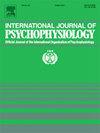在一个不确定的世界里,错误是否更令人厌恶?在一项随机对照试验中检验不确定性对误差相关消极性的影响。
IF 2.6
3区 心理学
Q3 NEUROSCIENCES
引用次数: 0
摘要
过度活跃的错误监测——由错误相关的负性(ERN)测量——是内化精神病理的一个候选的跨诊断风险标记。先前的研究报告了ERN与不确定性不耐受(IU)的个体差异之间的关联。这些发现暗示了IU的亚结构(前瞻性IU和抑制性IU)与ERN之间的关联,我们试图通过测试因果影响来复制和扩展这种关联,这些因果影响可能阐明这种关联的特定机制。为了检验不确定度与ERN之间的关联,采用了预登记的随机对照设计。在测量了N = 120名大学生的基线ERN后,将一个子样本随机分为两组:干预组(N = 30)执行旨在诱导状态不确定性的不可解概率“学习”任务,而被动对照组(N = 30)休息。随后,再次评估ERN。在干预前后评估自我报告的不确定性。为了进一步提高复制尝试的统计能力,我们在非预登记的相关分析中纳入了从不同研究地点收集的另外两个样本的数据。该分析包括来自N = 355名参与者的心理生理学数据。横断面上,未发现IU对ERN的影响。在状态不确定性诱导方面,干预组在干预后自我报告的不确定性增加,但没有证据表明干预导致了ERN的改变。IU和ERN的个体差异之间的联系可能比以前的研究结果显示的更小,更弱,反映了这种关联的未充分研究的特征。由于成功诱导状态不确定性而导致ERN发生机制变化的证据的缺失,进一步质疑了IU与ERN之间的联系。与先前的研究一致,将ERN增加与焦虑联系起来,独立于临床状态,ERN似乎不受短期变化(如非临床人群的症状挑衅)的影响。本文章由计算机程序翻译,如有差异,请以英文原文为准。
Are errors more aversive in an uncertain world? Testing the influence of uncertainty on the error-related negativity in a randomized controlled trial
Overactive error monitoring—as measured by the error-related negativity (ERN)—is a candidate transdiagnostic risk marker for internalizing psychopathology. Previous research reported associations of the ERN and individual differences in intolerance of uncertainty (IU). These findings imply associations between the subconstructs of IU (prospective and inhibitory IU) and the ERN, which we sought to replicate and extend by testing for causal influences that might elucidate specific mechanisms underlying this association. To test associations of uncertainty and the ERN, a preregistered, randomized-controlled design was employed. After measuring the baseline ERN of N = 120 university students, a subsample was randomly assigned to two groups: While an intervention group (n = 30) performed an unsolvable probabilistic “learning” task intended to induce state uncertainty, a passive control group (n = 30) rested. Subsequently, the ERN was assessed again. Self-reported uncertainty was assessed before and after the intervention. To further increase the statistical power of the replication attempt, we performed a correlation analysis (non-preregistered) by including data from two additional samples collected at different study sites. This analysis comprised psychophysiological data from a total of N = 355 participants. Cross-sectionally, no effects of IU on the ERN emerged. Regarding the state uncertainty induction, the intervention group displayed increased self-reported uncertainty after the intervention, but no evidence emerged for ERN alterations attributable to the intervention. The link between individual differences in IU and the ERN might be smaller and less robust than previous findings suggest, reflecting the understudied character of this association. The absence of evidence for mechanistic changes in the ERN due to a successful induction of state uncertainty further questions a link between IU and the ERN. In line with previous studies that linked increased ERN to anxiety, independent of current clinical status, the ERN seems unaffected by short-term changes such as symptom provocations in non-clinical populations.
求助全文
通过发布文献求助,成功后即可免费获取论文全文。
去求助
来源期刊
CiteScore
5.40
自引率
10.00%
发文量
177
审稿时长
3-8 weeks
期刊介绍:
The International Journal of Psychophysiology is the official journal of the International Organization of Psychophysiology, and provides a respected forum for the publication of high quality original contributions on all aspects of psychophysiology. The journal is interdisciplinary and aims to integrate the neurosciences and behavioral sciences. Empirical, theoretical, and review articles are encouraged in the following areas:
• Cerebral psychophysiology: including functional brain mapping and neuroimaging with Event-Related Potentials (ERPs), Positron Emission Tomography (PET), Functional Magnetic Resonance Imaging (fMRI) and Electroencephalographic studies.
• Autonomic functions: including bilateral electrodermal activity, pupillometry and blood volume changes.
• Cardiovascular Psychophysiology:including studies of blood pressure, cardiac functioning and respiration.
• Somatic psychophysiology: including muscle activity, eye movements and eye blinks.

 求助内容:
求助内容: 应助结果提醒方式:
应助结果提醒方式:


